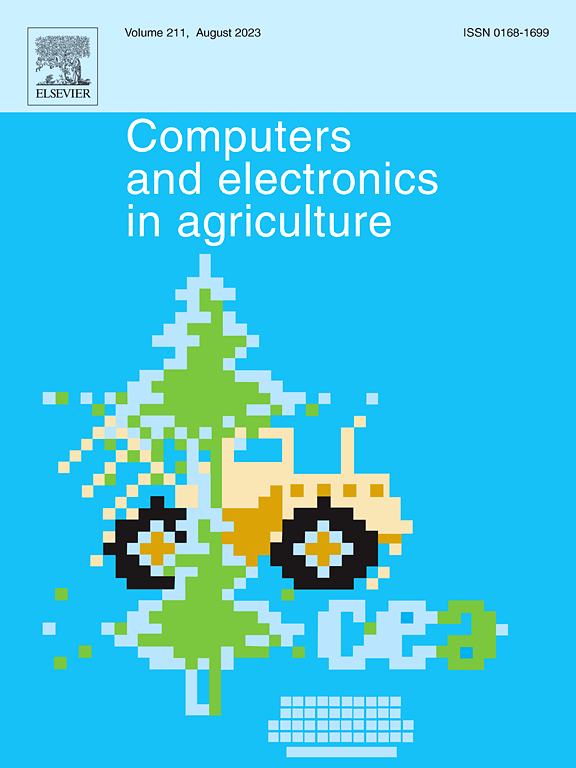Proximal sensors fusion and machine learning algorithm combined to improve soil compaction prediction
IF 8.9
1区 农林科学
Q1 AGRICULTURE, MULTIDISCIPLINARY
引用次数: 0
Abstract
Predicting adverse factors in agricultural production, like excessive soil compaction, is crucial for taking preventive measures that reduce costs, drying time, environmental contamination from chemical analyses, and the need for destructive sampling methods. Therefore, our objective was to predict soil compaction by evaluating regression and classification models using Random Forest algorithms based on the integration of a wide range of proximal sensors. A total of 56 undisturbed soil samples were collected in PVC cylinders from two soil types: Anionic Acrudox (LVdf) and Typical Hapludox (LVAd), and subjected to five compaction levels (70 %, 80 %, 90 %, 100 %, 110 %) under laboratory conditions. During the experiment, 475 measurements were performed using one X-ray emission sensor, three electrical property sensors, and volumetric water content was estimated from saturation to drying. This process generated 9,025 observations across 19 sensor-derived variables. By integrating the sensors, robust and accurate regression models were developed using Random Forest algorithms to predict compaction degree, with R2 = 0.93 when combining both soils and LVdf (R2 = 0.79; RMSE = 7.18) and LVAd (RMSE = 6.35). Excluding water content did not significantly reduce model accuracy but altered the importance of certain variables such as Fe, Si, Ti, and Zn. The pXRF was better at predicting compaction compared to electrical sensors, achieving an R2 = 0.78 for LVdf and LVAd. Classification models also performed well, reaching an overall accuracy of 0.92 (Kappa = 0.89), and Kappa values of 0.86 for LVdf and 0.74 for LVAd. Sensor fusion allowed variable analysis without disturbing soil structure, supporting potential large-scale spatial modeling for broader applications.

近端传感器融合与机器学习算法相结合,提高土壤压实度预测
预测农业生产中的不利因素,如土壤过度压实,对于采取预防措施,减少成本、干燥时间、化学分析造成的环境污染以及破坏性采样方法的必要性至关重要。因此,我们的目标是通过使用基于广泛近端传感器集成的随机森林算法评估回归和分类模型来预测土壤压实。在聚氯乙烯圆柱体中收集了56份未受干扰的土壤样品,分别来自阴离子酸还原(LVdf)和典型酸还原(LVAd)两种土壤类型,并在实验室条件下进行了70%、80%、90%、100%和110%的压实。在实验过程中,使用一个x射线发射传感器,三个电性能传感器进行了475次测量,并估计了从饱和到干燥的体积含水量。这一过程在19个传感器衍生变量中产生了9025个观测值。通过整合传感器,利用随机森林算法建立了稳健、准确的回归模型来预测压实度,结合土壤和LVdf时,R2 = 0.93 (R2 = 0.79;RMSE = 7.18)和LVAd (RMSE = 6.35)。排除水的含量并没有显著降低模型的准确性,但改变了某些变量如铁、硅、钛和锌的重要性。与电传感器相比,pXRF在预测压实方面更好,LVdf和LVAd的R2 = 0.78。分类模型也表现良好,总体准确率达到0.92 (Kappa = 0.89), LVdf的Kappa值为0.86,LVAd的Kappa值为0.74。传感器融合允许在不干扰土壤结构的情况下进行变量分析,支持潜在的大规模空间建模,用于更广泛的应用。
本文章由计算机程序翻译,如有差异,请以英文原文为准。
求助全文
约1分钟内获得全文
求助全文
来源期刊

Computers and Electronics in Agriculture
工程技术-计算机:跨学科应用
CiteScore
15.30
自引率
14.50%
发文量
800
审稿时长
62 days
期刊介绍:
Computers and Electronics in Agriculture provides international coverage of advancements in computer hardware, software, electronic instrumentation, and control systems applied to agricultural challenges. Encompassing agronomy, horticulture, forestry, aquaculture, and animal farming, the journal publishes original papers, reviews, and applications notes. It explores the use of computers and electronics in plant or animal agricultural production, covering topics like agricultural soils, water, pests, controlled environments, and waste. The scope extends to on-farm post-harvest operations and relevant technologies, including artificial intelligence, sensors, machine vision, robotics, networking, and simulation modeling. Its companion journal, Smart Agricultural Technology, continues the focus on smart applications in production agriculture.
 求助内容:
求助内容: 应助结果提醒方式:
应助结果提醒方式:


